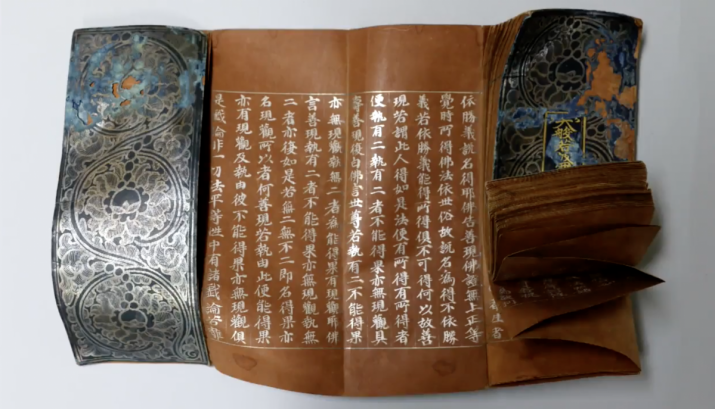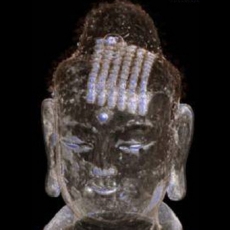NEWS
14th Century Scripture Discovered Inside Korean Buddha Statue
 The 14th century document, identified as a transcription of the Daebanyabaramildagyeong. From youtube.com
The 14th century document, identified as a transcription of the Daebanyabaramildagyeong. From youtube.comA Goryeo-era Buddhist scripture believed to date to the 14th century has been discovered concealed within the head of a Buddha statue at a Buddhist temple in Korea. The Research Institute of Buddhist Cultural Heritage said the ancient document was found when the statue underwent a 3D computer tomography (CT) scan.
Measuring 11.8 by 30.6 centimeters and inscribed in silver letters on paper made from fibers of the mulberry tree, the foldable scripture was identified as a transcription of the Daebanyabaramildagyeong—the 396th fascicle of the 600-volume Mahaprajnaparamita (Great Perfection of Wisdom) sutra, an encyclopedic collection of texts belonging to the same category as the Heart Sutra. Expounding the main Sutric paths a Bodhisattva must practice to attain Buddhahood, this voluminous work, which represents the fundamental philosophical work of Mahayana Buddhism, was translated by the renowned Chinese Buddhist monk, scholar, and traveler Ven. Xuanzang (c. 602–64), who brought three copies back to China from India.
“It is the first time to use the 3D-CT in our research on a Buddha statue,” said researcher Lim Seok-kyu at the Research Institute of Buddhist Cultural Heritage. “Through the research, we traced that the Silsang Temple Buddha contains a folded paper and letters written with a metallic material. Because we were deeply concerned about its condition, we decided to retrieve it for better preservation.” (The Korea Times)
 An image from the CT scan of the ancient Buddha statue. From english.donga.com
An image from the CT scan of the ancient Buddha statue. From english.donga.comThe seated Buddha statue, created in the early Joseon period (1392–1897), is one of about 20 extant Buddhas images in Korea made in the same style, although the statue’s outer appearance has been altered over the years due to repairs. The CT scan performed by the Research Institute of Buddhist Cultural Heritage also revealed the statue’s original form under the gilded exterior.
The remarkable find bears an inscription indicating that it was donated by one Yi Jang-gye and his wife, although no historical records have been found that shed any further clues as to the donor’s identity. “The scripture was made to honor their ancestors and to ward off bad luck,” said Lim. (The Dong-A Ilbo)
“[A] Buddhist scripture written in silver letters is very rare,” said Song Il-gi, a library science professor at Chung-Ang University. He noted that only four such scriptures have previously been found in Korea. Among them was one discovered inside a statue of Vairocana Buddha at Girim Temple, in the coastal city of Gyeongju, that has since been designated as a national treasure. (The Korea Times)
Located in Namwon, in South Korea’s North Jeolla Province, Silsangsa (True Nature Temple), a branch of Geumsan Temple in the city of Iksan, belongs to the Jogye Order of Korean Buddhism, a school of Korean Seon (Chan/Zen) Buddhism. Although renovated and rebuilt several times over the centuries, Silsangsa is believed to have originally been constructed during the reign of the Silla-era king Heungdeok (r. 826–36) by the monk Hongcheok, a student of the Chinese monk Zhiyi (538–97), founder of the Tiantai school of Chinese Buddhism. Silsangsa is the oldest temple among Korea’s nine mountain schools of Seon Buddhism.
See more
Scripture found inside Buddha statue's head (The Korea Times)
14th-century scripture found inside Buddha statue (The Dong-A Ilbo)
Related news from Buddhistdoor Global
South Korean Buddhist Monks Protest THAAD Missile Defense System
Eight Boys Ordained as Monks in Seoul Ahead of Celebrations to Mark Buddha’s Birthday
South Korea Seeks UNESCO World Heritage Status for Seven Mountain Temples
Korean Monk Dies of Injuries After Self-immolation Protest
Portland Art Museum to Repatriate Rare Buddhist Painting to Korea
Related features from Buddhistdoor Global
Korea’s Great Buddhist-Confucian Debate – Book Review: The Most Influential Ideological Conflict in East Asian History
From Seoul to Somerville: The Founding of a Korean Won Buddhist Temple in Massachusetts
Seon and the City














